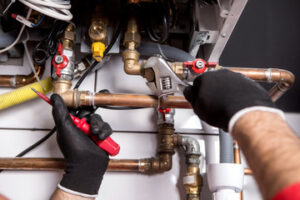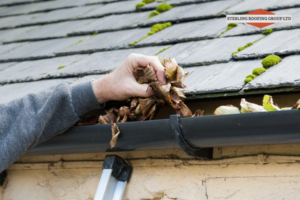Commercial plumbing involves large-scale waste disposal and water supply systems in high-rise office buildings, shopping centers, and hospitality suites. These spaces are used throughout the day, meaning the pipes and fixtures endure more wear and tear than in residential properties.
 This means that it is more likely for commercial plumbing to experience issues like leaks and clogs. So what separates commercial plumbers from residential plumbers? Read on https://www.apexdoyourplumbing.com/ to learn more.
This means that it is more likely for commercial plumbing to experience issues like leaks and clogs. So what separates commercial plumbers from residential plumbers? Read on https://www.apexdoyourplumbing.com/ to learn more.
The plumbing system in a commercial building is much more complex than in a residential building. The main reason is that the pipes in commercial buildings are usually longer and thicker than residential buildings. Moreover, the plumbing system in a commercial building is subject to a lot more wear and tear due to frequent usage. This means that the pipes are more prone to damage and need to be repaired often.
Additionally, the pipes in a commercial building are usually located underground which adds to their complexity. This is because underground pipes are more prone to damage from harsh weather conditions and the elements. The pipes are also more prone to corrosion. As a result, the pipes in a commercial building need to be more durable and of high quality to resist these problems.
Another reason why commercial plumbing is more complex is because it involves larger buildings and greater usage of water. For instance, a restaurant needs more sinks, toilets, and faucets than a home. Commercial spaces also tend to have a lot more people using them on a daily basis. This means that the pipes and fixtures in a commercial space are likely to experience more wear and tear.
Because of this, it’s important to hire a plumber with experience in commercial plumbing. They’ll be able to handle the bigger and more complicated systems and deal with the higher risk of damage. Furthermore, they’ll understand how to install and maintain hygienic plumbing fixtures that are required in restaurants and other commercial spaces.
In addition to being more difficult, commercial plumbing is also more expensive than residential plumbing. This is because the cost of materials and labor is higher for commercial plumbing jobs. Additionally, the plumbers may have to work outside of normal business hours in order to meet the demands of clients.
In addition, commercial plumbers must be able to follow a schedule and complete repairs within an established time frame. A plumbing problem in a commercial space can cause significant damage to the business and lead to losses for the owner.
Commercial plumbing is much more demanding than residential plumbing. This is because commercial plumbing deals with larger buildings and spaces that have more people using the facilities. For instance, a hotel or restaurant has hundreds of people using their toilets and sinks daily, while a home only has a few people living in it. This means that there is a lot more pressure on the plumbing system in a commercial space, and if something goes wrong, it can cause major damage quickly.
Larger buildings need bigger pipes and more fixtures to support their water systems. They also have to deal with higher usage and more wear and tear. That is why commercial plumbers are trained to identify and repair issues before they become catastrophic. In addition, commercial plumbing often involves dealing with different types of equipment and a wide range of regulations.
Many people are surprised to learn that commercial plumbing is not the same as residential plumbing. These differences are due to a variety of factors, such as the complexity of the work and the increased usage of the plumbing systems. It is important for commercial plumbers to be familiar with these differences in order to provide quality service.
Another difference between commercial and residential plumbing is that commercial spaces tend to be occupied during business hours, which makes it difficult for plumbers to work in those areas without disrupting the flow of business. This is why it is often better for commercial plumbers to schedule maintenance and repairs outside of business hours.
A third difference between commercial and residential plumbing is that commercial buildings have more users than homes. This means that the plumbing systems in commercial spaces must be designed to handle a high volume of usage, and they are subject to more wear and tear. Commercial plumbers are trained to install and maintain systems that can withstand heavy use, and they are also familiar with the necessary codes and regulations for commercial spaces.
Commercial plumbers are often required to deal with higher-risk plumbing problems than their residential counterparts. For example, a broken pipe on the 100th floor of a high rise can cause serious damage to the building below. That is why it is important for commercial plumbers to be licensed and insured.
When compared to residential plumbing, commercial plumbing comes with different requirements and has stricter health care laws. Keeping these laws in mind is vital for the safety of all occupants and visitors. For instance, commercial toilets, sinks, and showers must be easy to clean and drain off quickly. The water systems must also be able to handle more usage than residential ones and meet specific health care needs of all occupants in a particular area or building.
Due to the high-level of hygiene and standards required, a commercial plumber needs to have specific certifications to work on various projects. Some of these include backflow devices, fire pumps, booster pumps, multi-purpose sprinkler systems, chemical waste drainage systems, and vacuum waste systems. These require special permits that only licensed contractors can apply for and are usually done in conjunction with plans designed by an engineer.
Besides these, there are a number of other permits that may be needed when working on a commercial project. For example, an encumbrance or right-of-way permit might be needed to close off or narrow public walkways and roads while the project is underway. Similarly, a well/borehole permit might be required when working on plumbing in areas that have a water supply.
Healthcare construction is another area that requires commercial plumbing services. Since medical facilities must adhere to strict health care and hygiene laws, they must have robust plumbing systems that ensure a sanitary environment for the patients. For example, hospitals must have systems that manage the release of hazardous chemicals such as waste water and ensure that they do not enter the local water supply or the environment.
Commercial plumbing also deals with complex projects such as water system expansions and replacements for large buildings or new constructions of hospitals and other large public spaces. Such a job is not for everyone and only requires the expertise of a seasoned commercial plumber. In addition, these professionals are often responsible for the regular service maintenance of a building’s plumbing. This means that they are on-call to troubleshoot issues that might arise and take quick action before it gets out of hand. Moreover, the preventative maintenance of a building’s plumbing is essential to avoid costly repairs in the future.
The plumbing system in a commercial building has to accommodate many more people than the typical residential home. This can lead to more wear and tear and a higher risk of damage. Commercial plumbing also involves larger pipes and more complex designs. This means that it takes a professional with experience in commercial plumbing to get things working properly.
The most common issue that affects commercial plumbing is clogged drains. These can be caused by many different issues, including paper towels and other debris that is dropped into the drains. In some cases, it may be a sign of more serious issues such as a broken pipe or an overflowing sewer line. If the clog isn’t dealt with quickly, it can affect the whole building and create significant damage.
Another problem that commercial plumbers must deal with is leaky faucets and pipes. These can be very frustrating for business owners because they can cause a lot of water wastage and increase the cost of utilities. It is important for business owners to regularly inspect their plumbing systems and repair any leaks as soon as they are detected.
Lastly, one of the biggest issues that commercial plumbers must deal with is sewage smells. These can be extremely unpleasant and drive away customers and employees. It is essential to hire a professional to clean out the drains and repair any damage that is caused by the sewage smell.
The difference between commercial and residential plumbing is more complex than you might think. It is important to understand the differences between these two types of plumbing so that you can make the right decisions for your business. By doing so, you can avoid expensive and inconvenient plumbing problems in the future. If you have any questions or concerns about your commercial plumbing, contact a local plumber today. They will be able to help you keep your business running smoothly and efficiently. You can even schedule regular inspections to catch problems before they become severe. Having your plumbing system in good condition will save you time, money, and a lot of stress in the long run.

